      |
 |
 |
Dred
Scott
Dred Scott
was an enslaved man of "100 percent pure" African
descent. Dred’s case was predicated on the fact that he
was taken by his master, an officer in the U.S. Army, from the slave
state of Missouri to the free state of Illinois and then to the free
territory of Wisconsin. He lived on free soil for a long period of
time.
Born in Southampton, Virginia, in his youth, Dred Scott was known
as "Sam." He later changed his name to Dred Scott. He moved
with his master to Huntsville, Alabama and later to St. Louis, Missouri.
In 1831 his owner, Peter Blow, died and John Emerson, a surgeon in
the U.S. Army, bought him. He accompanied his new master to Illinois
(a free state) and Wisconsin (a territory). While in what is now
Minnesota, around 1836 he met and married Harriett Robinson. In
1843 Emerson died and left his estate to his widow Irene Emerson,
who refused Scott's demand for his freedom. He then obtained the assistance of
two attorneys who helped him to sue for his freedom in court.
|
Suggested Reading:
"They
Have No Rights,"
by Walter Erhlich
"Dred Scott v. Sandford: A Brief History With Documents,"
by
Dr. Paul Finkelman
"Dred Scott's Advocate: A Biography of Roswell M. Field,"
by
Kenneth C. Kaufman
"Lincoln and Chief Justice Taney: Slavery, Secession and the Presidential
War Powers,"
by James F. Simon
"Dred and Harriet Scott: A Family's Struggle For Freedom,"
by
Gwenyth Swain
"I, Dred Scott,"
by Shelia P. Moses
"George Washington Carver:
His Life and Faith in His Own Words,"
by
William Federer
"Slavery and the Making of America,"
by James Oliver Horton and
Lois E. Horton
"The Amazing Grace of Freedom:
The Inspiring Faith of William Wilberforce, the Slaves' Champion,"
by
Ted Baehr, Susan Wales, and Ken Wales
"Speak Right On:
Dred Scott: A Novel,"
by Mary E. Neighbour
"Up From Slavery,"
by Booker T. Washington
"Post Traumatic Slave Syndrome,"
by Dr. Joy DeGruy-Leary
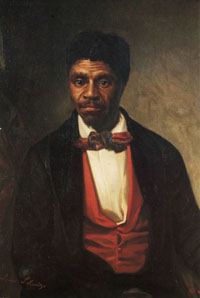
We invite you to become a Friend of Dred Scott...
Explore the facts about The Dred Scott Decision and share them with your family, friends and community and learn about
those who have been affected by this landmark "decision" throughout
history..
The Dred Scott Heritage Foundation welcomes your pledge of a contribution to advance our outreach and advocacy efforts.
Thank you in advance for your tax deductible donation to The Dred Scott Heritage Foundation.
Please mail your payment to:
The Dred Scott Heritage Foundation
P. O. Box 2009
Florissant, MO 63032-2009
—
OR —
For your convenience, we've provided a link to our private PayPal account below. Thank You.
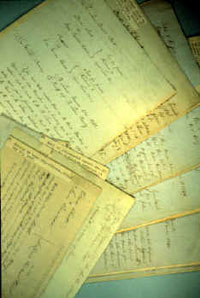
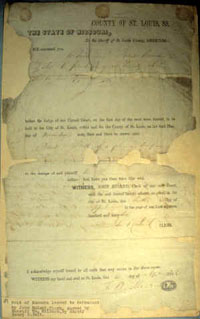
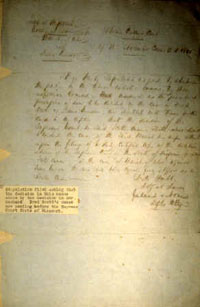
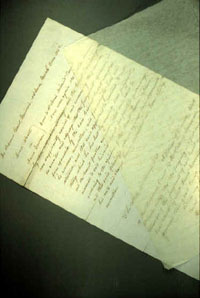
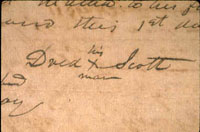
Images of "original case documents & correspondences" shown by permission courtesy: Washington University, St. Louis, MO.
To view actual Dred Scott Case archives, please contact: Washington University's Olin Library.
|
The
Story
One of the most important cases ever tried in the United States was heard in
St. Louis' Old Courthouse. The Supreme Court decided the case in 1857, and hastened
the start of the Civil War.
When the first case was first filed in 1846, Dred Scott was in his late 40s.
He was born in Virginia around 1799, and was the property, as his parents had
been, of the Peter Blow family. He had spent his entire life as a slave, and
never got the opportunity to learn to read. Dred Scott moved to St. Louis with
the Blows in 1830, but was soon sold due to Blow’s financial problems.
He was purchased by Dr. John Emerson, a military surgeon stationed at Jefferson
Barracks, in south St. Louis and accompanied him to posts in Illinois and the
Wisconsin Territory, where slavery had been prohibited by the Missouri Compromise
of 1820. During this period, Dred Scott married Harriet Robinson, also a slave,
at Fort Snelling; they later had four children, two boys that died in infancy
and two girls, Eliza and Lizzie. John Emerson married Irene Sanford during a
brief stay in Louisiana. In 1842, the Scott's returned with Dr. and Mrs. Emerson
to St. Louis. John Emerson died the following year, and it is believed that Mrs.
Emerson hired out Dred Scott, Harriet, and their children to work for other families.
On April 6th, 1846, Dred Scott and his wife Harriet filed suit against Irene
Emerson for their freedom. For several years, Scott had lived in free territories,
yet made no attempt to end his servitude. It is not known for sure why he chose
this particular time for the suit, although historians have considered three
possibilities: He may have been dissatisfied with being hired out; Mrs. Emerson
might have been planning to sell him; as well as he offered to buy his own freedom
and been refused. It is known that the suit was not brought for political reasons.
Most likely, friends in St. Louis who opposed slavery had encouraged Scott to
sue for his freedom on the grounds that he had once lived in a free territory.
In the past, Missouri courts supported the doctrine of "once free, always
free." Dred Scott could not read or write and had no money. He needed help
with his suit. John Anderson, the Scott's minister, may have been influential
in their decision to sue, and the Blow family, Dred's original owners, backed
him financially. The support of such friends helped the Scotts through nearly
eleven years of complex and often disappointing litigation.
It is difficult to understand today, but under the law in 1846 whether or not
the Scotts were entitled to their freedom was not as important as the consideration
of property rights. If slaves were indeed valuable property, like a car or an
expensive home today, could they be taken away from their owners because of where
the owner had taken them? In other words, if you drove your car from Missouri
to Illinois, and the State of Illinois said that it was illegal to own a car
in Illinois, could the authorities take the car away from you when you returned
to Missouri? These were the questions being discussed in the Dred Scott case,
with one major difference: your car is not human, and cannot sue you. Although
few whites considered the human factor in Dred Scott's slave suit, today we acknowledge
that it is wrong to hold people against their will and force them to work as
people did in the days of slavery.
|
The
Case
The
Dred Scott case was first brought to trial in 1846 on the first floor,
west wing courtroom of St. Louis' Old Courthouse. The Scotts lost
the first trial because hearsay evidence was presented, but they
were granted the right by the judge to a second trial. In the second
trial, held in the same courtroom in 1850, a jury of 12 white men heard
the evidence and decided that Dred Scott and his family should be
free. Slaves were valuable property, and Mrs. Emerson did not want
to lose the Scotts, so she appealed her case to the Missouri State
Supreme Court, which in 1852 reversed the ruling made at the Old
Courthouse, stating that "times now are not as they were when
the previous decisions on this subject were made." The slavery
issue was becoming more divisive nationwide, and provided the court
with political reasons to return Dred Scott to slavery. The court
was saying that Missouri law allowed slavery, and it would uphold
the rights of slave-owners in the state at all costs.
Dred Scott was not ready to give up in his fight for freedom for himself
and his family, however. With the help of a new team of lawyers who
hated slavery, Dred Scott filed suit in St. Louis Federal Court in
1854 against John F. A. Sanford, Mrs. Emerson's brother and executor
of the Emerson estate. Since Sanford resided in New York, the case
was taken to the Federal courts due to diversity of residence. The
suit was heard not in the Old Courthouse but in the Papin Building,
near the area where the north leg of the Gateway Arch stands today.
The case was decided in favor of Sanford, but Dred Scott appealed to
the U.S. Supreme Court.
|
The
Decision
On March 6, 1857, Chief Justice Roger B. Taney delivered
the majority opinion of the U.S. Supreme Court in the Dred Scott
case. Seven of the nine justices agreed that Dred Scott should
remain a slave, but Taney did not stop there. He also ruled that
as a slave, Dred Scott was not a citizen of the United States,
and therefore had no right to bring suit in the federal courts
on any matter. In addition, he declared that Scott had never
been free, due to the fact that slaves were personal property;
thus the Missouri Compromise of 1820 was unconstitutional, and
the Federal Government had no right to prohibit slavery in the
new territories. The court appeared to be sanctioning slavery
under the terms of the Constitution itself, and saying that slavery
could not be outlawed or restricted within the United States.
The American public reacted very strongly to the Dred Scott Decision. Antislavery
groups feared that slavery would spread unchecked. The new Republican Party,
founded in 1854 to prohibit the spread of slavery, renewed their fight to gain
control of Congress and the courts. Their well-planned political campaign of
1860, coupled with divisive issues that split the Democratic Party, led to the
election of Abraham Lincoln as President of the United States and South Carolina's
secession from the Union. The Dred Scott Decision moved the country to the brink
of Civil War.
Ironically, Irene Emerson was remarried in 1850 to Calvin C. Chaffee, a northern
congressman opposed to slavery. After the Supreme Court decision, Mrs. Chaffee
turned Dred and Harriet Scott and their two daughters over to Dred's old friends,
the Blows, who gave the Scotts their freedom on May 26, 1857. On September 17,
1858, Dred Scott died of tuberculosis and was buried in St. Louis at the old
Weslyan Cemetery near the streets that are now Laclede and Grand. His grave was
moved in the 1860s to Calvary Cemetery in northern St. Louis. His grave site at
Calvary was marked due to the efforts of the Rev. Edward Dowling in 1957 of the
Baden Historical Society. .
Dred Scott did not live to see the fratricidal war touched off at Fort Sumter
in 1861, but did live to gain his freedom. The ultimate result of the war, the
end of slavery throughout the United States, was not something Dred Scott could
have foreseen in 1846, when he decided to sue for his freedom in St. Louis' Old
Courthouse.
However, his
life, his purpose and indeed his destiny was to be forever a most integral
part of the destruction of an institution that when abolished, in large
part because of the perseverance of Dred and Harriet Scott, freed not
only a people but a nation from the grip of an unspeakable evil.
*Portions
of the above information published
by permission of the Jefferson National Expansion Memorial
& The Old Court House.
|
 |
To memorialize the ultimate impact of the Dred Scott Decision, we are working to develop, fund and install a likeness of Dred and Harriet Scott in the City of St. Louis. Information on how you can become involved will be forthcoming. Please watch for Dred
Scott Heritage Foundation Memorial Fund announcements.
|
      |
 |
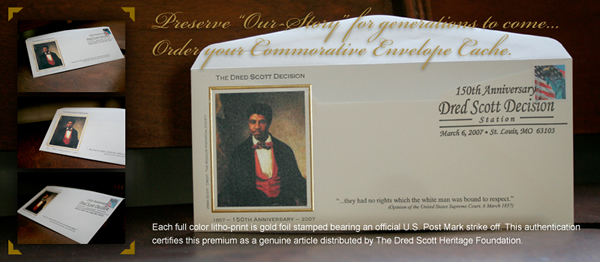 |
The "Authentic" Dred Scott Commemorative U.S. Post Mark cancellation stamp makes for an affordable and attractive gift.
Own "our" history today. Purchase the Limited Edition Commemorative Envelope Cache for only $5.00 while supplies last!To purchase, please send check or money order for $5.00 plus $3.00 S&H to:
The Dred Scott Heritage Foundation
P. O. Box 2009
Florissant, MO 63032-2009
|

*To
review a preferred list of online links to informative web sites and literature
click here: INFO
For more
information, please email us: info@thedredscottfoundation.org
©
2007 - 2009 The Dred Scott Heritage Foundation All Rights Reserved.
|











